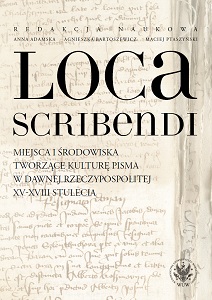Dwór królowej jako locus scribendi. Analiza wybranych aspektów funkcjonowania na przykładzie korespondencji Elżbiety Habsburżanki z Zygmuntem Augustem
The Court of the Queen as a locus scribendi. The analysis of some aspects of its role using the example of the correspondence of Elisabeth of Habsburg with King Sigismund August
Author(s): Urszula Zachara-Związek
Subject(s): Middle Ages, 6th to 12th Centuries, 13th to 14th Centuries, 15th Century, 16th Century, 17th Century, 18th Century
Published by: Wydawnictwa Uniwersytetu Warszawskiego
Keywords: writing community; consistory; notary public; writer; writing; office; books; 15th-18th century; writing culture
Summary/Abstract: Can the entourage of the 16th century spouses of Polish rulers be defined as a locus scribendi and, if so, what were its main characteristics? The detailed analysis of the correspondence between Elisabeth of Habsburg and her royal consort Sigismund August Jagiellon allows one to answer this question in the affirmative. Only nine letters of the queen have been preserved, including four from the period before 1543, when the young bride came to Poland from Austria and the marriage was concluded. Despite this modest amount, Elisabeth can be shown to be involved in acts of written communication. She manages to give a personal touch to the ‘standard’ letters to her husband, breaking with epistolary conventions.
- Page Range: 171-182
- Page Count: 12
- Publication Year: 2017
- Language: Polish
- Content File-PDF

